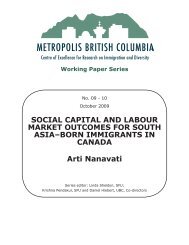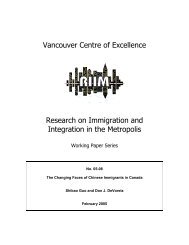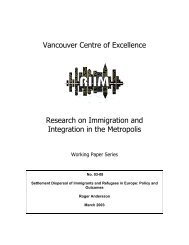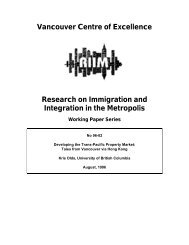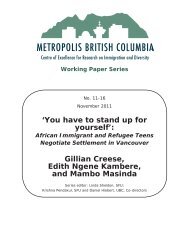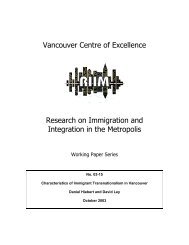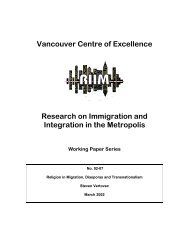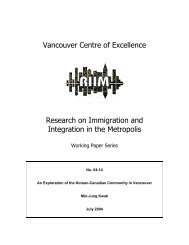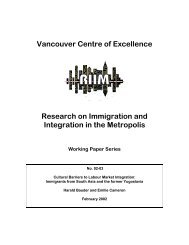The Quest for an Inclusive City - Metropolis BC
The Quest for an Inclusive City - Metropolis BC
The Quest for an Inclusive City - Metropolis BC
Create successful ePaper yourself
Turn your PDF publications into a flip-book with our unique Google optimized e-Paper software.
5<br />
between 1981 <strong>an</strong>d 2001, with Tamil org<strong>an</strong>izations estimating as m<strong>an</strong>y as 150,000 Tamils presently in<br />
Toronto, <strong>an</strong>d 20,000 in V<strong>an</strong>couver (Org4, Org6). According to Census data, 307 Tamils arrived in<br />
C<strong>an</strong>ada in 1981, but this number climbed steadily <strong>for</strong> the next two decades; reaching a highpoint of<br />
12,433 arrivals in 1992, <strong>for</strong> a total population of 95,672 by 2001. 3<br />
We also knew, impressionistically, that the Tamil population in Toronto was concentrated in<br />
two parts of the metropolit<strong>an</strong> area: one concentration adjacent to the downtown in the highrise St.<br />
Jamestown neighborhood, the other in the more dist<strong>an</strong>t suburb<strong>an</strong> areas of Scarborough <strong>an</strong>d North<br />
York. By contrast, the V<strong>an</strong>couver population seemed totally dispersed. So we wondered whether<br />
these geographies of settlement might be producing, or be reflective of, a different immigr<strong>an</strong>t<br />
experience <strong>an</strong>d different levels of integration. Finally, we wondered about the extent <strong>an</strong>d import<strong>an</strong>ce<br />
of Tamil community-based org<strong>an</strong>izations in assisting the settlement <strong>an</strong>d integration experience within<br />
the Tamil community. 4<br />
To get at some of these questions, we decided on a qualitative approach using, primarily, indepth<br />
interviews with members of the Sri L<strong>an</strong>k<strong>an</strong> Tamil communities in the two cities, <strong>an</strong>d interviews<br />
with members of Tamil community org<strong>an</strong>izations, <strong>an</strong>d secondarily, reviewing policy documents <strong>an</strong>d<br />
other city as well as community-based publications. <strong>The</strong>se interviews introduced us to a Tamil<br />
perspective on settlement, but the limitations of such a methodology me<strong>an</strong> that we c<strong>an</strong>not speak of<br />
‘the Tamil experience.’ 5 We also interviewed city officials, including a local politici<strong>an</strong> <strong>an</strong>d three<br />
social pl<strong>an</strong>ners in the <strong>City</strong> of Toronto, to help us underst<strong>an</strong>d the institutions of urb<strong>an</strong> govern<strong>an</strong>ce that<br />
were affecting migr<strong>an</strong>t integration <strong>an</strong>d the extent to which (<strong>an</strong>d how) city institutions are responding<br />
to immigr<strong>an</strong>t needs. <strong>The</strong>se Toronto interviews were mostly done during the Summer of 2002. Leslie<br />
Dickout, a Masters student at U<strong>BC</strong>’s School of Community <strong>an</strong>d Regional Pl<strong>an</strong>ning, conducted all of<br />
the interviews in Toronto, <strong>an</strong>d T<strong>an</strong>ja Winkler, a PhD student in the same School, conducted all<br />
3 <strong>The</strong> breakdown between Toronto <strong>an</strong>d V<strong>an</strong>couver, according to the Census, was 102 Tamils arriving in<br />
Toronto in 1981, rising to 10,220 in 1992, <strong>for</strong> a total of 71,799 by 2001: <strong>an</strong>d <strong>for</strong> V<strong>an</strong>couver, only 19 in 1981,<br />
rising to 174 in 1995, <strong>for</strong> a total of 2079 in 2001. <strong>The</strong>re is a vast <strong>an</strong>d irreconcilable discrep<strong>an</strong>cy between Tamil<br />
estimates <strong>an</strong>d Census data.<br />
4 One of the limitations of this research is that we did not track the work of non-ethnospecific immigr<strong>an</strong>t <strong>an</strong>d<br />
refugee org<strong>an</strong>izations, so our comments later in this paper about the inadequacies of integration c<strong>an</strong>not claim to<br />
be comprehensive.<br />
5 It is not only a methodological limitation that prevents us from speaking of ‘the Tamil experience’ but also a<br />
recognition that Tamils (like <strong>an</strong>y other ethno-culturally defined group) are very divided politically <strong>an</strong>d socially,<br />
despite sharing common fronts of marginalisation <strong>an</strong>d discrimination.



